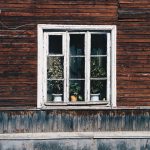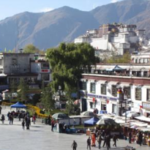(Updated July 2008)
(Part 1)
Instant Immersion
It doesn’t take long to get immersed in Berlin’s LGBT scene. 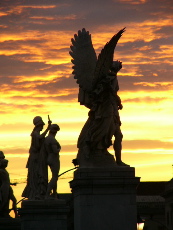 A quick subway ride to one of several ‘gay areas’ such as Schoneberg and this remade city of 3.5 million Deutschers suddenly feels familiar. Even before emerging from the elevated station of Nollendorfplatz I could see the ‘granddaddy’ of all LGBT stores in Europe, Bruno, the gay media supermarket owned by Bruno Gmunder, publisher if the venerable gay guide Spartacus. Inside is a veritable candy sore of erotic—hundreds of videos, books, toys, posters, clothing, lubricants, magazines, and angel-faced staff.
A quick subway ride to one of several ‘gay areas’ such as Schoneberg and this remade city of 3.5 million Deutschers suddenly feels familiar. Even before emerging from the elevated station of Nollendorfplatz I could see the ‘granddaddy’ of all LGBT stores in Europe, Bruno, the gay media supermarket owned by Bruno Gmunder, publisher if the venerable gay guide Spartacus. Inside is a veritable candy sore of erotic—hundreds of videos, books, toys, posters, clothing, lubricants, magazines, and angel-faced staff.
Immediately adjacent is the CSW Pride Parade offices which shares space with Mann O Meter, Berlin’s LGBT information and meeting 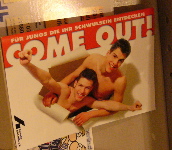 center brimming with free ‘zine magazines, dozens of brochures and booklets and post cards advocating safe sex (pix of aroused guys draw immediate attention!), social clubs, parties, HIV outreach services to immigrants (huge Turkish gay population here).
center brimming with free ‘zine magazines, dozens of brochures and booklets and post cards advocating safe sex (pix of aroused guys draw immediate attention!), social clubs, parties, HIV outreach services to immigrants (huge Turkish gay population here).
It hosts meetings for gay and lesbian youth (starting at 14 years old), senior gays, foreigners (in native languages), HIV-affected persons, AA, SCA, psychological counseling, video night, legal counseling. There is also a colorful café here.
Tucked in between Bruno and Mann O Meter is a tour and travel office, ‘ebab’, that specializes in gay B&Bs in Berlin and all of Germany. And standing out front on the street is a big life-sized rainbow bear waving to the world.
A few feet away stands a strange six-foot-tall object that in passing looks like an over-sized pencil stuck in the ground with its pointed end up. 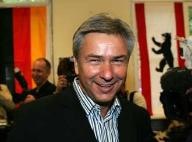 It’s easily unnoticeable and a casual visitor would never guess that it’s a memorial to the homosexuals murdered by the Nazis.
It’s easily unnoticeable and a casual visitor would never guess that it’s a memorial to the homosexuals murdered by the Nazis.
A more recent and more visible gay holocaust memorial was unveiled in May 2008 by the openly gay Mayor of Berlin, Klaus Wowerit (right).
The new memorial is situated in Berlin’s Tiergarten Park, close to the Brandenburg Gate and opposite the Jewish Holocaust Memorial. It is a four metre tall grey rectangular block (below) with a small opening through which viewers can see an art film scene of two men kissing. “A simple kiss could land you in trouble”, reads the inscription. See News Report)
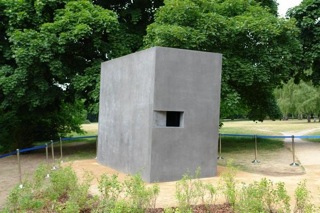
Meanwhile, back at Nollendorfplatz, is Café Berio where I was served by handsome David whose father came here from Guinea Bisau in western Africa. David served a hearty dinner and gave a brief survey of the immediate area which includes Christopher Isherwood’s apartment house at Nollendorfstrasse 17 where he invented the inimitable Sally Bowles (reborn on stage in Cabaret’) and the gay Hotel Sachsenhof where I booked a room. David didn’t have time to list the two dozen other LGBT local spots. It felt as if I were in Chelsea, Soho and Marais—combined.
The gay scene in Berlin is known for it parties, bars, saunas, hedonism and wild parades but as I sat in the balmy evening in this Schoneberg venue watching couples, singles, four-some clusters of friends (virtually all of whom spoke English) it was easy to see that there is a quiet and calm gay Berlin not hyped on meth and sweating to huge sounds and lights.
In Berlin the LGBT choices are endless. Shall I go to a gay film? A gay café for dinner? A sauna? A bar with a dark room? A disco with techno-retro music at deafening volume? A gay support group? A gay youth coffee bar? A gay Turkish club? A sex party? Should I volunteer time at the LGBT Man-O-Meter help center or hotline? Attend a talk on gay history? A transgender workshop? An art gallery with a new photo exhibition of ‘A Man’s World’? A talk by Gore Vidal? A gay friendly church or synagogue? Or a lecture on being a gay youth in Germany? Not to mention the ballet, opera, dance, comedy show or the Ernst Busch High School presentation of Virginia Woolf’s ‘Orlando’… or a swing through Bruno Gmunder’s, not forgetting a visit to the Gay Museum. Or maybe to a press conference with Berlin’s mayor Wowerit.
Berlin has two major ‘happening’ magazines, Siegessaule (Victory Tower) and ‘Sergeij’ that are distributed at hundred of venues every month. If you are planning a trip to Berlin and intend to play in the scene you should order these ahead of time and take a week to plan out your itinerary.
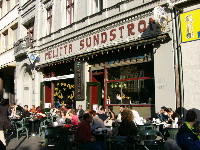 Or you can wander around one or all of the gay ‘areas’ of Berlin and happen upon an appealing site. There are four or five gay vortices, depending on how many venues constitute a density that can be called a scene. The three most popular and populous areas are Schoneberg, Prenzlauer Berg and Kreutzberg. The handy little booklet ‘Out in Berlin’ does a nice job of identifying and mapping out the scores (hundreds!) of LGBT venues on it pages.
Or you can wander around one or all of the gay ‘areas’ of Berlin and happen upon an appealing site. There are four or five gay vortices, depending on how many venues constitute a density that can be called a scene. The three most popular and populous areas are Schoneberg, Prenzlauer Berg and Kreutzberg. The handy little booklet ‘Out in Berlin’ does a nice job of identifying and mapping out the scores (hundreds!) of LGBT venues on it pages.
Schoneberg
It’s’ only possible of course to see a few places on a short visit. My first night here I went to three different venues in ascending in ‘erotic order’.
First, Café Berio in Schoneberg is a fine and quiet place for coffee, beer or a good meal. I ate tasty pasta ‘abendessens’ there twice. In warm weather the outdoor seating (shiny aluminum tables and chairs) allows for a pleasant ambience of people watching. Just around the corner from Berio are more than twenty other choices such as the ever-popular Heile Welt café, Bedroom Bar with its chic white lounges and tables, the historic Blue Boy and Tabasco, to name only a few. Also nearby is the Cillibum club in the huge art deco Metropole building. It’s unusual in that it is one of only two gay Turkish clubs.
 My next stop, around the corner, was Tom’s Bar, a landmark of gay Berlin. (http://www.tomsbar.de/ –most of these venues have web sites) Inside, the lights were dim with the usual standup bar and, going further toward the back, a room with sofas for viewing porno videos. On weekends tightly-clad go-go dancers don’t take long to strip down and please the crowd. This is one place to find out immediately that Berlin is definitely not inhibited.
My next stop, around the corner, was Tom’s Bar, a landmark of gay Berlin. (http://www.tomsbar.de/ –most of these venues have web sites) Inside, the lights were dim with the usual standup bar and, going further toward the back, a room with sofas for viewing porno videos. On weekends tightly-clad go-go dancers don’t take long to strip down and please the crowd. This is one place to find out immediately that Berlin is definitely not inhibited.
My third place of ‘inspection’ was the Steam Sauna a few blocks from Schoneberg’s subway stop, Nollendorfplatz. Of course I only went for journalistic reasons (really!) and found the place cheerfully decorated with bright wall colors, soft lighting, clean floors, private rooms, two dark steam rooms and one very dry and hot sauna room. No Jacuzzi but there was a very cold dipping tub. The receptionist said the most popular times were during the week after work. The Friday night of my visit less than two dozen patrons appeared to be there. The entry cost was Euro 14.50 (about US$27).
On the way to and from the sauna I saw another side of the sex scene in Berlin: standing along Einemstrasse, one of the main cross streets of Schoneberg, three or four women prostitutes dressed in outrageous outfits that clearly marked their trade. Thigh-high shiny patent leather boots (some black, some white) with three-inch-high platform shoes; mini (meaning miniscule) skirts that revealed the lower part of their asses; very short chest-length jackets with pockets at breast level so the ladies could puff out their boobs; and of course stylized bouffant hair in jet black or fire red and each with Barbie doll makeup They seemed to be doing a brisk business; as I walked past, three cars stopped and picked them up, although one took a longer time to negotiate leaving the passenger door open until the deal was made. They were still talking when I turned the corner.
Prenzlauer Berg
My next night of lesbigay surfing took me to a set of gay eateries and cafes in another gay area called Prenzlauer Berg.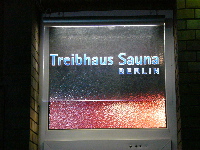 Using my handy gay guide Out in Berlin I easily navigated to Rice Queen, an Asian restaurant (obviously) where they serve a colorful and tasty array of lunches and dinner. My cashew chicken was served by a pretty-faced youth named Suedi from Indonesia who is studying economics in Berlin. It seemed that most of the waiters I spoke to were foreign students going to school.
Using my handy gay guide Out in Berlin I easily navigated to Rice Queen, an Asian restaurant (obviously) where they serve a colorful and tasty array of lunches and dinner. My cashew chicken was served by a pretty-faced youth named Suedi from Indonesia who is studying economics in Berlin. It seemed that most of the waiters I spoke to were foreign students going to school.
Not to be outdone by Schoneberg, Prenzlauer offered it own menu of sex clubs like Duplexx among numerous gay and lesbian cafes such as Gubbi, Amsterdam, Schall & Rauch, QX, and, of course, another sauna, this one called Triebhaus.
Kreuzberg
A third day of subways and walking brought me to the Kreuzberg area, popping in to another collection of bars, video-toy stores and quiet cafes. The most popular café is Melitta Sundstrom which fills its sidewalk tables, on sunny mornings and afternoons, with relaxed patrons sipping coffee or lager.
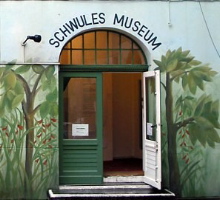 Behind Sundstrom is the world’s only Gay Museum (http://www.schwulesmuseum.de/ ). It’s entered through an archway and leads into three rooms of exhibits. This fall the museum was focusing on the French gay philosopher Michel Foucault. The web site states: “To mark the 20th anniversary of his death, the Gay Museum is dedicating an exhibition to the life and work of Michel Foucault. Next to Jean-Paul Sartre, Foucault may be seen as one of the most important men of French thought in recent history. For him, too, philosophy was a political act aimed at bringing about change.”
Behind Sundstrom is the world’s only Gay Museum (http://www.schwulesmuseum.de/ ). It’s entered through an archway and leads into three rooms of exhibits. This fall the museum was focusing on the French gay philosopher Michel Foucault. The web site states: “To mark the 20th anniversary of his death, the Gay Museum is dedicating an exhibition to the life and work of Michel Foucault. Next to Jean-Paul Sartre, Foucault may be seen as one of the most important men of French thought in recent history. For him, too, philosophy was a political act aimed at bringing about change.”
Not surprising all the texts, descriptions and films were in German (which I speak only a little) so my appreciaton was limited. 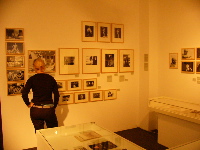 But the prize exhibit is the museum itself. It is very much of a flagship for LGBT Berlin, however modest in size. No other country in the world, including Holland, Australia, England or Scandinavia, has stepped forward with the resources, support and confidence to mount such a venue. It was a proud moment to walk through its doors. A lengthy description of the museum and its offerings can be see at http://www.glbtq.com/arts/schwules_museum.html
But the prize exhibit is the museum itself. It is very much of a flagship for LGBT Berlin, however modest in size. No other country in the world, including Holland, Australia, England or Scandinavia, has stepped forward with the resources, support and confidence to mount such a venue. It was a proud moment to walk through its doors. A lengthy description of the museum and its offerings can be see at http://www.glbtq.com/arts/schwules_museum.html
Kreuzberg is also an area heavily populated by Turkish people and of course many queer Turks. (There are an estimated three million Turkish immigrants living in Germany.) I had read that gay Turks, who are virtually all Muslims, live a very closeted double life with families and straight friends in their neighborhoods. Since Kreuzber’s Turkish population is overwhelmingly heterosexual the two most popular bars and discos among gay Turks are located well out of sight even though there are numerous other gay venues in the area. Doubtless, most non-gay Turks consider the queer hedonism of Berlin as a white man’s ‘disease’.
Sadly, the gay Turkish community is not well accepted into the larger LGBT community Despite having the largest immigrant population of any western European country, there is a discernable discriminatory attitude in Germany toward Turks. Many families have been German residents for over twenty years but don’t have citizen status or voting rights. It’s no surprise that these gay Muslims don’t feel a part of the gay mainstream.
They have a particularly daunting challenge in coming out and living gay even in Berlin. Their family and religious traditions are vehemently anti-gay yet they demand loyalty and obedience. There is no room for such unacceptable practices as homosexuality. 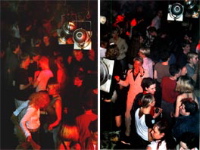 So they are an unfortunately insulated group: they’re not well integrated into the larger Berliner gay community and they are not accepted by their own ethnic community. So it’s a great relief for many to have their own space and time when they can be themselves and go dancing at Cillibum in Schoneberg and the SO 36 disco in Kreuzberg on certain nights. The ‘SO’ attracts a mixed and more alternative crowd than other clubs so the Gayhane Turkish party night here is very popular (right). (See News Report)
So they are an unfortunately insulated group: they’re not well integrated into the larger Berliner gay community and they are not accepted by their own ethnic community. So it’s a great relief for many to have their own space and time when they can be themselves and go dancing at Cillibum in Schoneberg and the SO 36 disco in Kreuzberg on certain nights. The ‘SO’ attracts a mixed and more alternative crowd than other clubs so the Gayhane Turkish party night here is very popular (right). (See News Report)
Beyond LGBT Life
Of course a visit to Berlin is not spent entirely in interior, dark, steamy or smoky places. The pulse of this city—gayand straight–is arguably more vibrant, hedonistic and visual than any major city in the world. It also sprouts cutting-edge architecture, countless cafes from grunge to ultra chic, world class museums filled with plunder from ages ago when taking whole temples from Greece, Turkey and Persia was acceptable. Fast and easy subways, buses and trolleys move people from the central ultra buildings at Potzdamer Platz to the huge 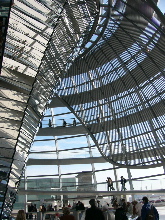 baroque
baroque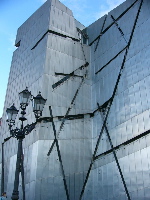 palaces of gay king Frederick the Great (1742-85) in suburban Potsdam to the huge slick and trendy shopping centers along Friedrickstrasse not far from the powerfully symbolic Brandenburg Gate.
palaces of gay king Frederick the Great (1742-85) in suburban Potsdam to the huge slick and trendy shopping centers along Friedrickstrasse not far from the powerfully symbolic Brandenburg Gate.
The dynamic Reichstag building (left) is perhaps the crown jewel and symbol of reborn Berlin. Norman Foster’s swirling glass and mirror dome is a stunning achievement of engineering and design. The hour wait to enter and walk up the dome is worth the time. Another stunning architectural feat is the new Jewish Museum (right) where a nice acknowledgement of Magnus Hirschfeld–the first sex researcher to defend gays–can be found. He was recently honored in central Berlin where a stretch of the River Spree was named in his memory. See News Report)
Dinner with Briand Bedford
My exploration of a few bars, clubs, saunas, cafes, bookstores and museums was important for me to see gay Berlin before I talked about it. After a few days of walking around famous and infamous neighborhoods in the less attractive former eastern sector and the more upscale western sector, both with LGBT venues, I shared an evening with a man who knows gay Berlin very well. Part of our time was in a stylish Indian restaurant ‘Amrit’ in Schoneberg
Briand Bedford is paid to know gay Berlin very well. He is the editor in chief of Spartacus Gay Guide published each year by Bruno Gmunder since 1979. (Before that the guide was put out by an ex-Anglican priest who founded the guide and traveled the world researching his own material.)
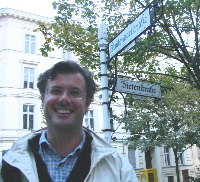 Briand (right) is British but fell in love with a Berliner eleven yeas ago and has lived here since. It’s his job to see that Spartacus comes to together each March, which is a daunting challenge with thousands of entries from all over the world that need verifying annually. Fortunately he has not been jaded or numbed by his work and was cheerfully willing to talk about gay Berlin. (Or was it the cheeriness of our handsome dark waiter from Punjab?)
Briand (right) is British but fell in love with a Berliner eleven yeas ago and has lived here since. It’s his job to see that Spartacus comes to together each March, which is a daunting challenge with thousands of entries from all over the world that need verifying annually. Fortunately he has not been jaded or numbed by his work and was cheerfully willing to talk about gay Berlin. (Or was it the cheeriness of our handsome dark waiter from Punjab?)
In my reading about gay Berlin I sensed an ‘edge’ to the LGBT Berlin scene, a rather in-your-face, “I’m here-I’m queer’ confident strength of presence that I have noticed in few cities in the world. Briand confirmed this edge: “there is an aggressive sexuality here that you don’t find elsewhere. It’s teutonic, I think, a daring and urgent force. In the last Pride Parade there were floats with naked porn stars fucking (or simulating it) as they passed in front of countless onlookers. I think it’s bad taste and is overkill but it tells you the kind of boldness that’s here–not to mention all the dark rooms in gay bars and discos in Berlin.”
Such audacious conduct carries over, in summertime, when a portion of Berlin’s huge central park, Tiergarten, is taken over by nude weekend sunbathers, mostly gay and lesbian volke. It’s affectionately known as “Tunten-wiese” or “Queens’ Meadow,” where legions of gays sunbathe au naturel. The park is right in the middle of the city and is visited by thousands of non-gay Berliners but no protest is made and no laws are being broken. Nudity seems to be a virtual non-issue for most Germans. A trip to any beach on the Mediterranean in summer reveals bare-breasted northern European women, often from Germany, languishing in the sun.
Briand and I were sitting in a quiet residential middle/upper middle class neighborhood (Schoneberg) in a fine restaurant among well dressed patrons who drove late-model cars and were mostly employed and mostly straight. Yet within five blocks more than twenty homo venues were open for business—for beer, cruising, food, videos, books, chatting, sleeping—and sex. I don’t recall seeing a single policeman or fundamentalist in the area. (There are of course anti-gay ruffians in the lower working class areas of Berlin.)
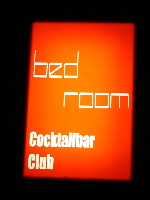 I expressed to Briand that no one seemed bothered by the cornucopia of carnality in the neighborhood. “It’s about money, the laws and tolerance. A business that makes money is welcome here and if it’s a gay business straight people know the gays will make it look nice as well. (In fact, he said, straight people prefer to rent flats to gays because they know they will fix it up and take care of it-as opposed to a family with kids.) When gays buy in a neighborhood people know the values will go up because of this.”
I expressed to Briand that no one seemed bothered by the cornucopia of carnality in the neighborhood. “It’s about money, the laws and tolerance. A business that makes money is welcome here and if it’s a gay business straight people know the gays will make it look nice as well. (In fact, he said, straight people prefer to rent flats to gays because they know they will fix it up and take care of it-as opposed to a family with kids.) When gays buy in a neighborhood people know the values will go up because of this.”
Briand continued, “As for sex in private between adult it’s of course not against the laws. Discreet nudity is permissible in public. Tolerance here I think also comes from the history. People know very well what happened here sixty years ago. Intolerance had terrible consequences. They don’t dwell on it but they haven’t forgotten it.” Indeed, this city is punctuated with memorials of many kinds to those who perished under the guns and camps of intolerance.
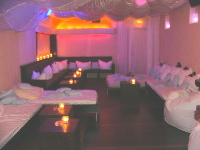 “Yet we have all this but no gay marriage,” Briand added. It’s somewhat surprising especially in light of the openly gay governing mayor of Berlin. But he doesn’t use his office to advocate specifically for gay rights. He is very supportive of gay activism and appears at rallies and conferences. But he has said “I am not a gay politician but a politician who is gay. And that is a good thing.”
“Yet we have all this but no gay marriage,” Briand added. It’s somewhat surprising especially in light of the openly gay governing mayor of Berlin. But he doesn’t use his office to advocate specifically for gay rights. He is very supportive of gay activism and appears at rallies and conferences. But he has said “I am not a gay politician but a politician who is gay. And that is a good thing.”
I wondered what ‘social effect’ this easy and available and present sensuality might have on the LGBT community, on relationships. I thought perhaps such easy access to sex might weaken the desire for or value of LGBT relationships.
Briand: “Actually relationships here carry a certain prestige. Most gay people want them and if you are in your forties or fifties and single people wonder why. Most of our friends are couples. But there are places here that cater to older gays who are still looking, such as the ‘Dreizehn’ (13) and ‘Old Timer’ bars. You also find young people there because they like older guys.” Indeed there are a lot of young LGB people who are attracted only to others over 50 but the sterotype seems  always to be reversed. “We have a friend who is about 70 now and he always has great stories to tell about the young guys he meets—some are in their twenties! That’s another good thing about living in this open minded city–we talk easily about these things. Even sex is discussed among friends when we get together.”
always to be reversed. “We have a friend who is about 70 now and he always has great stories to tell about the young guys he meets—some are in their twenties! That’s another good thing about living in this open minded city–we talk easily about these things. Even sex is discussed among friends when we get together.”
But what about all the sex joints within a few minutes walk of your conjugal home? Is that a distraction? A temptation? Briand smiled calmly. “In this city it is 99% accepted that any long term relationship is an open one. Not at first of course, but maybe in five years or so when the love and trust is there. After that it’s normal to have experiences outside. In fact I had two tickets to a sex party and I gave them to my partner and told him to go and have a good time. I don’t worry about him anymore—after 11 years we are OK.” Briand thought that attitudes in other German cities, however, were less open.
Another question to Briand concerned lesbians in Berlin. One morning for breakfast I went to the popular Sundstrom café with its old world bohemian ambience. While I was there numerous lesbians came in to eat as well. They were decidedly masculine in their clothing and hairstyles, a dress code that is called ‘Drag King’ in Berlin. They huddled in pairs or threes to catch up with gossip or plan a private party that would not likely include guys. Aside from these few women I had not seen many lesbians in the cafes, bars and clubs. Briand said that lesbians have a more closed community here and were not well integrated into the larger more visible gay male community except for festivals and parades.
Discos
Berlin is well known for its brassy and ballsy gay discos but I didn’t have time to see them. In a follow-up message from Briand he reported:
There are a few discos which are good. On Friday and Saturday nights Connection in Fuggerstraße is very popular. Most people go there not only to dance but is a large underground darkroom on two floors. The first level has cubicles with TV screens, showing porn videos. The lower level has a few rooms with TV screens, a dark room, and more cubicles. When someone says he wants to go dancing in Connection…we all know what he means!
On Sunday night/Monday morning is the GMF Party in Café Moskau. This is for very young gays and is the place to be seen. Especially popular with those who do not have to work on Monday as it starts at 10pm and ends around 4am! See http://www.dancefloorguide.de/berlin/cafe-moskau
Die Busche in the Warschauerstr. is probably Berlin’s oldest disco. The music is fab from the 70ies and 80ies and all ages can be found here. There are a large number of so-called “Kampflesben” (dykes) here but the ages are mixed as is the music. See: http://www.dashausb.de/
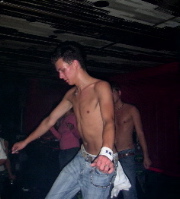 A relaxed and reasonably priced place to go is my favorite: Schwuz, Mehringdamm, entrance through café Melitta Sundström, (adjacent to the Gay Museum). Reasonable prices and popular with a friendly, mixed crowd.
A relaxed and reasonably priced place to go is my favorite: Schwuz, Mehringdamm, entrance through café Melitta Sundström, (adjacent to the Gay Museum). Reasonable prices and popular with a friendly, mixed crowd.
A final word should go to SO 36 in Kreutzberg. The “SO” attracts a mixed and more alternative crowd than other clubs. The most popular parties are Electric Ballroom, Café Fatal (ballroom dancing) and the bingo party. There is also the Gayhane party night here which is popular with Turkish gays.
Any story about gay Berlin is inevitably incomplete. This will do for now from me. Following here is another slant of the vast Berlin LGBT scene.
(Part 2)
Intro: Intrepid travelers Mark Sullivan and friend Christine venture into the Berlin night without a map but they are never lost for long. With hundreds of LGBT venues throughout the city nightlife the choices are many and the scene as radically chic as anywhere on the planet.
By Mark Sullivan
The OutTraveler
Summer 2004
“Excuse me,” one of them said as the other three crowded around us. “Do you know how we get to a club called Rio?”
My friend Christina, an American who had been living in Berlin for two years, replied that we were looking for the same place. The women seemed convinced that the club was a block or two south, but we told them that the doorman of a bar had pointed us in the other direction. Unimpressed with our source, they ran across the street to ask someone else.
We should have known better.
Both Christina and I had been to bars and clubs in Berlin that were in the back of an apartment complex or in the basement of an office building. One had been at a construction site, and we huddled in the darkness with several strangers until a door opened and someone gestured for us to hurry inside. Not one of these places had been easy to find. What made us think that we could locate this place?
We did find it, though. At 2:10 A.M. as we stood outside the padlocked gate, we realized that we had come on the wrong night.
“Welcome to Berlin,” Christina enthused. “You can’t say you’ve really experienced the city until you’ve wasted hours searching for the hottest club.”
Bowling for Berlin
Bowling was the last thing I had in mind when Christina and I headed to the neighborhood of Prenzlauer Berg on Friday night. But there I was, in the basement of a smoky little bar called August Fengler, standing in front of the most narrow pair of lanes I had ever seen. Whether this made it easier or harder I couldn’t figure out, as the two blond boys who were playing consistently threw gutter balls. “Want to give it a try?” one of them asked me, just before his boyfriend pressed him against the wall and playfully nibbled on his neck.
I declined, not certain I could do any better. I maneuvered around the Foosball tables and climbed up the steep steps to the ground floor. I spotted Christina, who was wearing her pink wool cap. She was admiring the gaudy glass chandeliers hanging over the bar, which she said was a sure sign that this place dated back to when this neighborhood was a part of East Berlin.
I glanced around at the other patrons. Most were young and straight, but the crowd was not as predominantly straight as I would have guessed. My two bowling buddies weren’t the only other gay guys there. I spotted two men standing by the door, two more by the bar. And what about that table full of women in the corner?
It’s been almost 15 years since the fall of the Berlin Wall, and walls are crumbling all over the place.
Not that there aren’t plenty of gay establishments in the city. Pick up a copy of Siegessaule or Sergej, the city’s gay-bar rags, and you’ll find listings for close to 150 bars and clubs. Longtime favorites such as S036, where the city’s huge Turkish population turns out for dance parties with male belly dancers, and GMF, a cavernous dance club where techno reigns supreme, still have lines around the block. It’s just that now the options have increased exponentially.
For about a century, gays have been gathering in Schoneberg, a tangle of streets directly south of the Siegessaule, the enormous victory column in the center of the Tiergarten. Christopher Isherwood and W.H. Auden came here in the Roaring Twenties during the heady days of the Weimar Republic, enjoying the wild parties in bars like Eldorado. It’s still here at Motzstrasse 20, as is the apartment house at Nollendorfstrasse 17 where Isherwood created the unforgettable Fraulein Sally Bowles. And the Tiergarten itself remains queer: Southwest of the victory column is an area affectionately dubbed “Tunten-wiese” or “Queens’ Meadow,” where fields of gays sunbathe au naturel in the summertime.
After World War II the city’s gay population grew too big for Schoneberg. Many gays living in the West began moving to Kreuzberg, a bohemian enclave in the shadow of the Berlin Wall. (The Schwules(Gay) Museum, a gay archive that opened here in 1985, is located at Mehringdamm 61.) In East Berlin, they gravitated to gritty Prenzlauer Berg and Friedrichshain, where a somewhat flourishing scene existed in the face of dour socialism. Then the wall came tumbling down in 1989, and dozens of gay bars and clubs moved forward into the empty storefronts in these neighborhoods.
Schoneberg is still the center of gay life, which is why it hosts Christopher Street Day, a gay pride celebration to be held this year on June 26 (outdone only by the massive, omnisexual, techno-fused Love Parade that fills the Tiergarten on July 1). But you’d seldom see a woman walk into a gay bar in Schoneberg, or a man accompany his women friends to a lesbian party. In Kreuzberg and Prenzlauer Berg, which have always been more about breaking down borders, the lines have been blurred, though.
Christina and I continued to the Bar zum Goldenen Hirschen, a happening spot in Prenzlauer Berg just down the street from August Fengler. Like many of the newer bars in this neighborhood, there’s no sign outside. A curtain is pulled over the floor-to-ceiling windows, keeping the place incognito.
The doorman checks for our names on the computer, then waves us inside. After scoping out the place, we collapse onto a banquette next to two women who look like models. They work for a television studio, and are keeping an eye on the handsome actor who is working the room. They anticipate our next question and inform us that he is straight.
“But I think he might be the only straight man here,” one of them adds, glancing about the room. She’s exaggerating a bit. But at least half of the people perched on the white barstools or leaning against a wall painted in broad stripes in sorbet colors are gay. The DJ buzzes from group to group, distributing kisses like palm cards.
The loungy music puts us in a mellow mood. The two women eventually move on, and so do we. We have a lot of places we want to see before the weekend comes to an end.
The Road to Rio
Saturday afternoon found me in Prenzlauer Berg once again, browsing in the boutiques huddled around the intersection of Kastanienallee and Oderberger Strasse. Five designers joined forces to open Eisdieler, so named because they moved into a storefront once occupied by an ice cream parlor. You can join in the nostalgia for the socialist days of the German Democratic Republic with a sweatshirt emblazoned with the goldtinted glass block called the Palace of the Republic (once the parliament building for East Germany, it is slated for demolition).
A few doors down is a clothing store called Eastberlin, where I try on a few belts with buckles that resemble those on airplanes. They don’t have my size here, so I head down to Mitte to the other branch on Alte Schonhauser Strasse. I can’t help but notice that most of the shops along this street don’t bother to put up signs. That’s why I almost passed by Ito, also recommended by a friend.
Christina had plans with her cousin, so I decided to meet an acquaintance at a venue called White Trash. Nobody had bothered to take down the decorations of the former tenant, which had been a Chinese restaurant. White Trash just added more, so now the ceiling is strung with pirate flags and pinatas.
We crowded around a table with eight or nine other people, mostly expats. Three members of a band called Sex in Dallas are celebrating being signed by a record label. Two people are with Sex in Dallas’s management company One is a DJ who is remixing one of the band’s singles. The talk inevitably turns to the club scene.
“It used to be that everyone would go to the gay clubs,” said the DJ, taking a drag off a cigarette. “They always had better music, right? But I think that things have changed a lot in the past couple of years.”
“You’re right,” said one of the musicians. “Now people just go where they like the music, whether it’s a gay place or not.”
Our group began heading toward the door sometime before 2 A.M., discussing how many taxis we’d need to get to Rio. We were soon standing in front of the now-familiar gates. One of the members of the band said he was on the guest list, but the doorman seemed dubious. He punched a few buttons on his cell phone, and the owner emerged to escort us inside.
Backstage was crowded with couples of different sexual orientations making out on worn-out couches. Someone had dumped out the contents of a purse on a coffee table, and the band that would be playing that night was applying makeup that seemed suitable for A Clockwork Orange.
As I pushed open the door to the club, I could feel the heavy thumpthump-thump coming from the speakers. This was a small dance floor holding just a few dozen people. As I leaned against the wall, I spotted a familiar pink cap. Christina had ditched her cousin so she could check the place out. We headed to the main room, a cavernous space that had once been a warehouse. Video screens on three sides of the dance floor showed George W. Bush moving like a puppet.
We danced in the main room until almost 4 A.M. On our way out, I noticed the music on the smaller dance floor had changed to cheesy disco—so uncool that it’s cool. A group of three or four gay guys near the DJ cheered every time he mixed in a new song. I smiled. It was good to know some things will never change.
Mark Sullivan is the writer of numerous travel guidebooks for Fodor’s Travel Publications. His work has appeared in Billboard, Interview, and InStyle.
Also see:
Gay Germany Stories
Gay Germany News & Reports 2000 to present
Gay Berlin Photo Galleries

